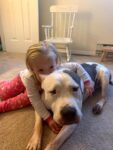Everyone has seen those photos of dogs and little humans where the child is sitting on the dog. Cute right? Nope! To allow that kind of behavior puts your child at risk of a dog bite. Even the most trustworthy dogs have their limits. On average, every year there are 400,000 children who need medical attention due to a dog bite. So let’s talk about how to teach children to respect dogs.
Before you get into how to teach children to respect dogs, make sure you understand How To Introduce Your Dog To A Baby!

Always Supervise
There should never be a time that your dog and child are left unattended. The one second that they are by themselves is when a freak accident could occur. Making sure that someone is always watching children and dogs interact is the best way to prevent an incident from occurring.

Even if your dog is the most trustworthy dog or you have taught your child everything there is to know about dogs, it is not worth the risk. Dogs will hit a limit and children will always test boundaries. If someone is there supervising, there will be a quicker response to intervene if it is necessary. It takes only a second for a dog to snap a correction nip when they feel cornered or uncomfortable. It also only takes a second to correct a child for inappropriate behavior and prevent an incident.
Know and Understand Your Dog’s Breed
Dog breeds are more than just a label that a dog has. Every dog breed has their own personality quirks and behaviors. It is in their DNA. It is extremely important to understand your dog’s breed and make sure that you listen to their needs.
If you have a herding breed, do not be surprised if they try to herd your baby around as they learn to crawl and walk. Just make sure your dog is given a job to do and they may not feel so inclined to herd the children.
With guarding breeds, be very cautious when new people are interacting with your baby. That is going to be your dog’s person and they will protect them if they feel like they have to.
Some dog breeds were bred to bite. Like German Shepards, Rottweilers, Doberman Pinscher, ChowChows, etc. Know this and make sure you are proactive in teaching your dog and child to respect each other.
Dog’s DNA is just another reason to keep supervision as a top priority. If you feel you need extra help with this, reach out to a dog trainer for training and support.
Teach Children To Speak Dog
Help Your Child Understand Dogs Can Be Dangerous
It’s a fact, dogs can be dangerous. Children should be taught this and understand it. You don’t need to scare a child into thinking every dog is going to hurt them, but they should understand that a dog can revert to a bite if they feel they need to use it.
Teach your child that dogs communicate with their mouth. They mouth us to encourage play but they can also give a nip to warn you they’ve had too much. Let your child know they need to respect a dog’s space and boundaries so they do not feel like they need to communicate negatively with their mouth.
Dogs also have claws that can cause damage. Make sure you let your child know that when playing with a dog it is important the dog keeps their paws on the ground. If jumping up is encouraged, at some point a doggie toenail will cause a scrap.
Teach Children To Respect Dogs By Their Body Language
Dogs communicate with us with their body language. They do not have the ability to say “hey that upsets me!” Make sure that your child understands the basics of dog body language so they can see how the dog is feeling and react accordingly.

Some basic body language responses that should be taught are leaning away, wide eyes, and a low grumble or growl. If a dog is leaning away and has wide eyes, they are uncomfortable with whatever is near them. They may start to feel cornered and that they cannot escape. A dog feeling this way for a significant amount of time may offer a correction to whatever is nearby to get themselves out of that situation.
Growling is a huge communication tool for dogs. This is how they give a warning right before a big communication action. Never ever correct a dog for growling. They are trying to talk to you and if you correct them for growling, next time there may not be a growl to warn you. Teach your child that a growl means back away. Something is upsetting your dog and they need space immediately!
Just as important as the nervous body language is the play body language. Let your child know what a dog play bow is and that it means play time. Show your child that when a dog brings a toy to you, it means they want you to play with them. Make sure they understand the good behavior just as well as the warning behavior.
Teach Your Child What Their Body Language Should Be Like
Just as important as dog body language is, so is human body language! The biggest thing that children should understand is to relax around dogs. Dogs want to be able to read and understand the motions that humans are making. If a child has excitable behavior, the dog may get confused and nervous around them.
Make sure your child understands not to run around dogs. No jumping around. Absolutely no loud screeching or yelling. Some dogs will find that all upsetting. Children will have outbursts of energy, it happens! If it is happening and your child cannot be redirected at that time, then get the dog out of the scenario until the child zoomie is completed. This way, your child is getting some energy out and your dog is safe.
How To Teach Children To Respect Dogs
Dogs are a species that is all about respect. You respect them, they’ll respect you. Teach your child how to show dogs respect and how to interact appropriately with them.
Ask For Permission
This is so important for safety around dogs! Never approach a dog you don’t know and attempt to pet them. You know nothing about their background and can put yourself in harm’s way by just attempting to pet a dog.
Teach your child to ask the owner of the dog for permission to pet the dog and then to wait for permission to be granted. Also teach your child that if someone says, “no” that it is okay! Not every dog needs to be petted, as much as we want to pet them all! Ask the owner the reasoning why the dog should not be petted and use that as a teaching moment for the child.
Approach Slowly
Dogs do not like to be rushed up to. It can be very intimidating and even scary for some dogs. Make sure your child understands this and knows to always walk calmly up to a dog. Never run up to them. Even if they are your dog, walking gets you to the same endpoint as running, just safer.
Teach Children To Respect Dogs by Letting Dogs Come To Them

For dogs that are not familiar to you, let them approach you. Dogs will adjust better to new people if they approach them, when the time is right. Teach your child to wait for the new dog to come see them. Once they are there, pet appropriately.
Teach Your Child How to Pet A Dog
You would think petting a dog wouldn’t be a science but it is! When you meet a new dog, it is more appropriate and respectful towards the dog to pet under their chin and on their back. If it is a more familiar dog, feel free to let your child pet the head as well.
One thing to teach your child is to not hug a dog unless given permission. Some dogs may not react well to hugs because they may feel cornered. If your child wants to hug a dog, make sure they have permission first and are supervised doing it.
Teach Your Child How To Play with A Dog

After petting, the next best thing a child will want to do with a dog is play! Teach your child about inappropriate and appropriate games to play with a dog. Fetch and tug-o-war are great games. Chasing your dog, not so much. Also make sure your child understands that hitting, kicking, and pulling a dog is not appropriate play behavior!
Give Your Child A Dog-Related Chore
GIving your child a chore in regards to your family pet is a great way to show them how to respect the dog and the relationship they have with the family.
Make Your Child Be In Charge of The Dog’s Treat Time
Are there certain times a day that the dog gets a treat? Make that task something that your child does! Have them ask the dog for a sit, then give them the treat once they’re behaving.
Note: It is safer to teach your dog to take a treat gently before having a child take on this task!
Have Your Child Do Your Dog’s Meals
Dogs and children love meal times! So have the kiddos feed your dogs. Teach your child how much food goes into the dog’s bowl. Then have them ask the dog for a sit, put the bowl down, and release them to enjoy their meal! Children always get a kick out of this chore!
Do A Family Walk
Walks are so good for dogs and children! If you have a dog that is good on leash and not too bad of a puller, have your child take charge walking them for the family outing. They will love feeling like they have such a big responsibility.
However you want your child involved in your dog’s life, make sure it is respectful and with love!
